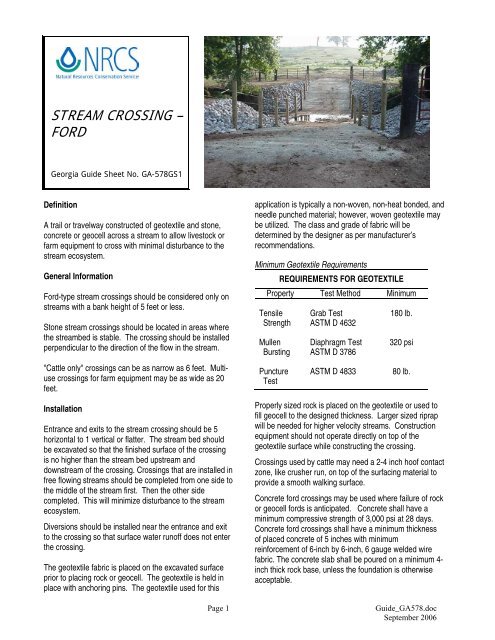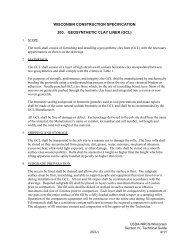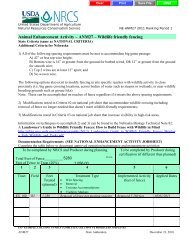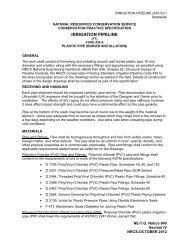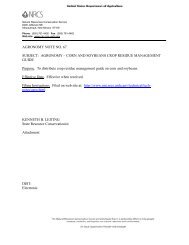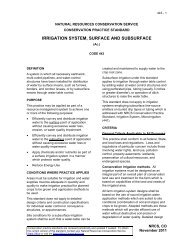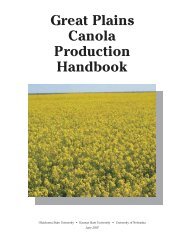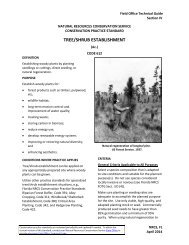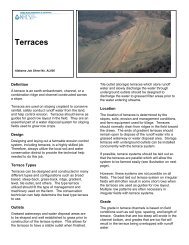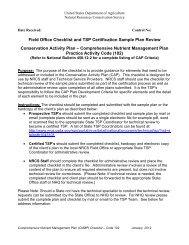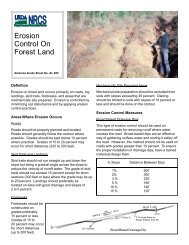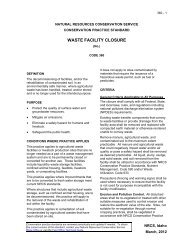STREAM CROSSING – FORD
STREAM CROSSING – FORD
STREAM CROSSING – FORD
You also want an ePaper? Increase the reach of your titles
YUMPU automatically turns print PDFs into web optimized ePapers that Google loves.
<strong>STREAM</strong> <strong>CROSSING</strong> <strong>–</strong><br />
<strong>FORD</strong><br />
Georgia Guide Sheet No. GA-578GS1<br />
Definition<br />
A trail or travelway constructed of geotextile and stone,<br />
concrete or geocell across a stream to allow livestock or<br />
farm equipment to cross with minimal disturbance to the<br />
stream ecosystem.<br />
General Information<br />
Ford-type stream crossings should be considered only on<br />
streams with a bank height of 5 feet or less.<br />
Stone stream crossings should be located in areas where<br />
the streambed is stable. The crossing should be installed<br />
perpendicular to the direction of the flow in the stream.<br />
"Cattle only" crossings can be as narrow as 6 feet. Multiuse<br />
crossings for farm equipment may be as wide as 20<br />
feet.<br />
Installation<br />
Entrance and exits to the stream crossing should be 5<br />
horizontal to 1 vertical or flatter. The stream bed should<br />
be excavated so that the finished surface of the crossing<br />
is no higher than the stream bed upstream and<br />
downstream of the crossing. Crossings that are installed in<br />
free flowing streams should be completed from one side to<br />
the middle of the stream first. Then the other side<br />
completed. This will minimize disturbance to the stream<br />
ecosystem.<br />
Diversions should be installed near the entrance and exit<br />
to the crossing so that surface water runoff does not enter<br />
the crossing.<br />
The geotextile fabric is placed on the excavated surface<br />
prior to placing rock or geocell. The geotextile is held in<br />
place with anchoring pins. The geotextile used for this<br />
application is typically a non-woven, non-heat bonded, and<br />
needle punched material; however, woven geotextile may<br />
be utilized. The class and grade of fabric will be<br />
determined by the designer as per manufacturer’s<br />
recommendations.<br />
Minimum Geotextile Requirements<br />
REQUIREMENTS FOR GEOTEXTILE<br />
Property Test Method Minimum<br />
Tensile Grab Test 180 lb.<br />
Strength ASTM D 4632<br />
Mullen Diaphragm Test 320 psi<br />
Bursting ASTM D 3786<br />
Puncture<br />
Test<br />
ASTM D 4833 80 lb.<br />
Properly sized rock is placed on the geotextile or used to<br />
fill geocell to the designed thickness. Larger sized riprap<br />
will be needed for higher velocity streams. Construction<br />
equipment should not operate directly on top of the<br />
geotextile surface while constructing the crossing.<br />
Crossings used by cattle may need a 2-4 inch hoof contact<br />
zone, like crusher run, on top of the surfacing material to<br />
provide a smooth walking surface.<br />
Concrete ford crossings may be used where failure of rock<br />
or geocell fords is anticipated. Concrete shall have a<br />
minimum compressive strength of 3,000 psi at 28 days.<br />
Concrete ford crossings shall have a minimum thickness<br />
of placed concrete of 5 inches with minimum<br />
reinforcement of 6-inch by 6-inch, 6 gauge welded wire<br />
fabric. The concrete slab shall be poured on a minimum 4inch<br />
thick rock base, unless the foundation is otherwise<br />
acceptable.<br />
Page 1 Guide_GA578.doc<br />
September 2006
The concrete will extend down into toe trenches that are<br />
6 inch wide and 18 inch deep on the upstream and<br />
downstream edge of the crossing. The toe trenches will<br />
extend half way up the stream approaches.<br />
A 3 foot wide and 18 inch thick rock rip-rap apron<br />
should be installed along the downstream edge of the<br />
concrete to dissipate velocity and provide head cut<br />
protection. The apron shall extend half way up the<br />
stream approaches. The apron may be omitted in low<br />
gradient streams where the design storm velocity is less<br />
than 5 feet per second.<br />
Each side of the crossing should be fenced so the cattle<br />
will be restricted to the protective crossing surface,<br />
eliminating unrestricted access to the stream. Electrified<br />
hanging chains have proven to be an effective and<br />
minimal maintenance type fence used in conjunction with<br />
stream crossings.<br />
Shade should be eliminated in the immediate vicinity of<br />
the crossing so that cattle will not have a tendency to loaf<br />
in the stream at the crossing location.<br />
Operation and Maintenance<br />
In order for the stream crossing to provide protection to<br />
the stream ecosystem, the riparian zone for the stream<br />
should be fenced, with cattle access only at the crossing.<br />
Periodic inspection of the stream crossing will be required.<br />
Storm runoff may deposit debris at the crossing location<br />
which will need to be removed. The stone may<br />
occasionally need to be replaced. Fence repair and<br />
maintenance may be needed.<br />
References<br />
NRCS GA Conservation Practice Standard<br />
Code-561, Heavy Use Area Protection<br />
Code-578, Stream Crossing<br />
Page 2 Guide_GA578.doc<br />
September 2006


